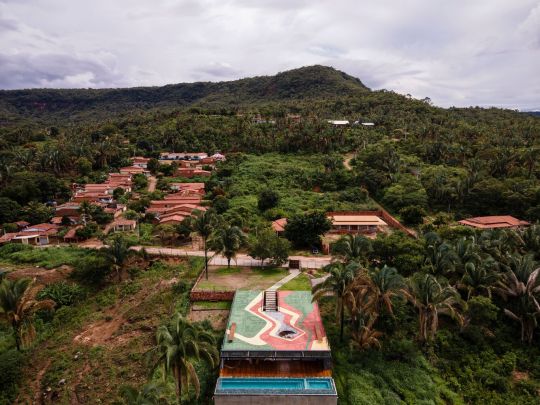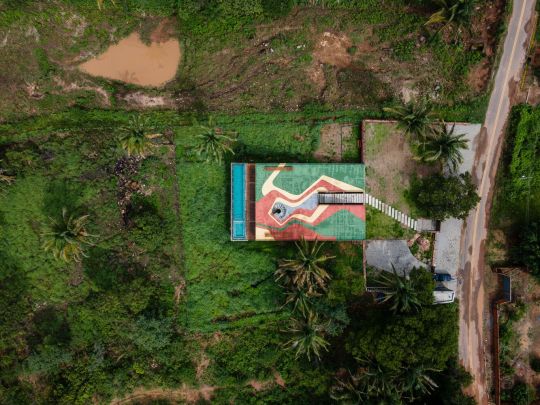#araripe plateau
Explore tagged Tumblr posts
Text
















Casa Tune, Cariri, Ceará, Brazil,
FB+MP Arquitetos Associados
#art#design#architecture#minimal#interior design#minimalism#interiors#tropical#tropical house#brazil#ceara#cariri#casa#casa tune#patterns#FB+MP arquitetos#araripe plateau#belvedere
155 notes
·
View notes
Photo

Araripe Manakin - Antilophia bokermanni
This songbird is endemic to the Chapado de Araripe plateau in northeastern Brazil, and has only been known to science since 1998. The males are white with black wing and tail feathers and a red crest, similar to the Helmeted Manakin, while the females are olive green. The population size has been estimated as anywhere from 150 to 700 individuals, and is continuing to decline. Due to their incredibly limited range, this species is very vulnerable to habitat loss caused by agriculture and development. The construction of several tourism and recreational facilities, including a water park in 2000 at the site where the species was discovered, have led to deforestation of the Araripe Manakin’s habitat and resulted in severe declines in their population size.
#beauty on the brink#Critically Endangered#araripe manakin#manakin#bird#sixth extinction#endangered species#Illustration#Natural History illustration#sciart
21 notes
·
View notes
Text
Southern Hemisphere’s first known feathered dinosaur had weird rods
The fossil of a chicken-sized, meat eater from Brazil that had a mane of fluffy filaments and a pair of stiff, ribbon-like streamers rising from each shoulders is the primary dinosaur with feathers ever found within the Southern Hemisphere.
Named Ubirajara jubatus, the plucky predator lived 110 million years in the past and possibly used its unusual shoulder feathers and mane for display purposes to draw mates and keep at bay rivals, a world group of researchers reviews on-line December 13 in Cretaceous Analysis.
The title Ubirajara means “lord of the spear”’ and comes from the native Tupi Indigenous language, whereas jubatus comes from the Latin for maned or crested.
Many dinosaurs from the supercontinent of Gondwana, which coated a lot of the southern half of the planet through the Cretaceous Interval, have been assumed to have had feathers, however it’s thrilling to lastly have direct proof, says research coauthor David Martill, a paleontologist on the College of Portsmouth in England.

Signal Up For the Newest from Science Information
Headlines and summaries of the most recent Science Information articles, delivered to your inbox
“These [shoulder] buildings are actually elaborate; they made this animal look fairly spectacular, simply as a chook of paradise seems spectacular [today],” he says. “When birds have these types of feathers, they do all types of posh dances and shows, so this dinosaur seems prefer it was a bit of show-off.”
The dinosaur can also be fascinating, as a result of it’s a member of the compsognathid group, which branched off from the household tree of carnivorous dinosaurs pretty early within the historical past of the group, Martill says. That means that using feathers for advanced show functions might have a really historic historical past throughout the carnivorous dinosaurs.
Max Langer, a paleontologist on the College of São Paulo who was not concerned within the analysis, says it was solely a matter of time till a feathered dinosaur was found within the Crato Formation in northeastern Brazil, the place the fossil got here from, or the encompassing rocks of the Araripe Plateau. Right here, “the fossilization is pristine” with many specimens recording even particulars equivalent to muscle fibers and blood vessels, he says.
Numerous different dinosaurs with out feathers have been discovered within the area. And a chook fossil with feathers, described in 2015, confirmed feather preservation within the rocks right here was potential.
Langer provides that it’s a disgrace that an essential fossil like this has ended up in Germany, somewhat than remaining in Brazil, and that Brazilian scientists weren’t concerned on this analysis. “The fossils discovered listed below are a part of the Brazilian paleontological heritage, so it’s not good that this materials is in another country,” he argues.
The fossil was in all probability discovered by native quarrymen who extract paving slabs from the fossil-bearing limestones of the Crato Formation, says research coauthor Eberhard Frey, a geoscientist on the State Museum of Pure Historical past Karlsruhe in Germany.
Within the early Nineteen Nineties, the fossil arrived on the paleontological museum within the metropolis of Crato in Brazil’s Ceará state. Right here, it got here to the eye of Frey and Martill, who sought permission from native officers to export the fossil to Germany in 1995, the place they’ve studied it within the intervening years, and the place it stays at the moment.
Source link
from Diaspora9ja https://diaspora9ja.com/southern-hemispheres-first-known-feathered-dinosaur-had-weird-rods/?utm_source=rss&utm_medium=rss&utm_campaign=southern-hemispheres-first-known-feathered-dinosaur-had-weird-rods
0 notes